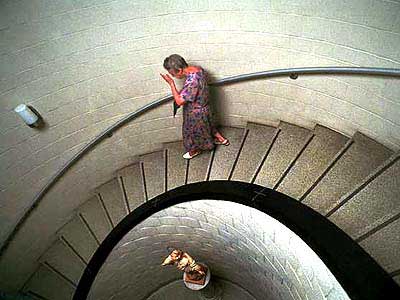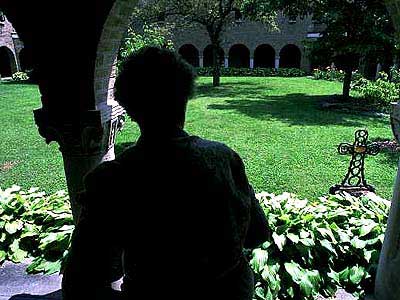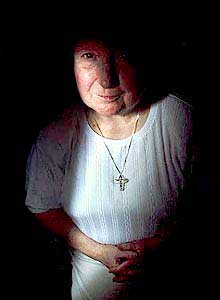|
Opening
a Citadel of Prayer
Their
order facing extinction, 11 Carmelite nuns end decades of solitude
and go dot-com. 'The life we lead, it has to go on,' one says.
By
STEPHANIE SIMON
Times
Staff Writer
August
3 2002
INDIANAPOLIS--Secluded
in a fortress of stone, behind thick, high walls to block the
world, the Sisters of Carmel of the Resurrection pray.
Their
monastery bristles with battlements, commanding a hill. Inside,
the 11 aging nuns walk polished halls in austere silence. Their
retreat is a blankness of white walls without end, of oak doors
shut tight. The only sound is the prayer bell chimes.

The
Carmelites of Indianapolis do not teach or nurse or spread the
faith, as other Roman Catholic sisters do. Private prayer is
their vocation.
Theirs
is not a formal supplication on bended knee. It is a meditation.
They unfold their souls and they wait for words to come. The
sisters pray as they sit in their rocking chairs, watching the
birds peck seeds. They pray as they walk through the courtyard
garden, a tangle of green.
They
venture out of the monastery but rarely. It has been rarer still
for them to invite outsiders in. The isolation has brought
them joy. It has also brought them crisis.
The
Carmelites have not welcomed a new member in a dozen years.
Their average age is 70. Two sisters have died in the last few
months and another is ill.
To
ensure that the contemplative life they cherish will survive
them, the nuns have taken a momentous decision. They have forsaken
the seclusion that defined them.
They
have not given up their two hours a day of private prayer, or
their morning and evening silence. They still celebrate a daily
Mass. They still make a modest living selling altar bread and
prayer books. They still rotate the chores so each sister takes
a turn with the laundry, the cooking and the yard work.

But
the Carmelites of the Resurrection have opened up their fortress.
It has been a startling journey. Nuns of such simplicity
that they live on $1 a day have put their future in the hands
of an ad agency famous for fast-food commercials. Sisters
who were once so isolated they didn't know the Vietnam War had
begun have requested advice from the security director for the
NFL's Indianapolis Colts--who gave them all team T-shirts.
The
Carmelites hired a part-time development director, Linda Hegeman,
to represent them. She rounded up an advisory board of two dozen
prominent citizens, each with a skill she thought might help
the sisters navigate a world they had long since left behind.
The
advisors--most but not all Catholics--included a software designer,
a public relations specialist, an administrator from the local
Catholic college and a former city police chief, now working
security for the Colts. The group is eclectic, but effective:
Meeting every month or two, its members pushed the nuns to move
beyond their original vision of a promotional brochure to consider
a punchy online campaign that had them posting their private
prayers on the Internet.
Timid
at first, the sisters prayed over each suggestion--and ended
up taking most of them, with gusto. They now consider their
advisors as friends, hosting pizza parties for the board inside
the monastery.
"It
has been a stretch," Sister Joanne Dewald says.
In
the arched hallways of the monastery they helped build, the
sisters with hearing aids and white hair are determined to keep
stretching. They have discovered unexpected joy in engaging
the world. Their revolution has enriched their faith. It has
also brought them hope for a future. Nearly halfway through
a five-year outreach plan, the Carmelites are speaking with
several young women who might be interested in joining.
"The
vocation is so dear to us," says Sister Rachel Salute,
76. "To see it dying out.... " She stops. She has
been a Carmelite nun since 1953.
"You
would go to such extremes," she says, "to prevent
your community from dying."
"The
life we lead, it has to go on," says Sister Ruth Ann Boyle--at
age 45 the youngest by two decades. "Just as much as the
work of teachers or nurses needs to go on, the life of prayers
must go on."
"It's
a calling. It's a service," Sister Joanne says. As a girl,
she dismissed the Carmelites as "loony." Now 72, she's
the monastery prioress--and she is convinced that when women
give their lives to prayer, their devotion can help heal the
world. "It's hard to explain this life. It doesn't make
much sense," she says. "But you're drawn to it."
Sister
Joanne first suggested several years ago that the nuns consider
reaching out to young women who might feel that same mysterious
call.
The
concept was not novel. As the number of nuns in the United States
has plunged--from 180,000 in 1965 to fewer than 74,000 today--many
orders have tried marketing. Dominican nuns in Michigan ran
a commercial on "The Oprah Winfrey Show" with the
tagline: "Life is Short. Eternity Isn't." The Sisters
of Mercy in New York advertise in bus shelters, asking: "Do
You Have a Call Waiting?"
For
the Carmelites, though, self-promotion did not come easy.
Like
other cloistered sisters--there are at most 4,000 in the U.S.--the
Carmelites of Indianapolis live sparingly, eating but one cooked
meal a day and sleeping in barren cells with barely enough room
for a bed, a desk and a chair.
For
decades, they were so sequestered that neighbors had no idea
whether nuns or monks lived behind the imposing turrets. The
nuns could not leave the monastery, even to visit a dying parent.
Relatives could visit just one hour a month, talking to the
sisters through an iron grate so thick, even fingertips could
not touch.

The
nuns' main interaction with outsiders took place through the
"turn," a wooden cabinet set on a turntable at the
front door of the monastery. Visitors would place messages or
packages in the cabinet. A veiled sister on the other side of
the wall would spin it, wordlessly, to her. Sometimes, to the
nuns' discomfort, Catholic parents seeking a blessing would
place a baby in the cabinet. The sister inside would offer a
hasty prayer, then whisk the newborn back.
That
extreme isolation began to ease in the late 1960s, when the
Second Vatican Council called for reforming church life and
its rituals.
The
nuns started shopping for groceries instead of having them delivered.
They ordered their first newspaper subscription. They even began
opening their morning Mass to local Catholics; on weekdays,
a dozen visitors might gather with them behind the blue glass
doors of the chapel.
Even
now, however, the nuns keep their forays to the outside world
brisk: They buy groceries at Sam's Club (or pick up Subway sandwiches
as a treat) and then promptly return. They don't stop to chat.
They don't go out for fun. They shun what they call "clutter"--any
interaction that distracts them from prayer. Sister Joanne still
turns down invitations to address young women at the Catholic
college down the street.
So
it was a remarkable leap when--at the suggestion of their development
director--the sisters invited half a dozen executives from the
ad agency Young & Laramore to the monastery two years ago
to discuss marketing.
They
met in the reading room, the only space in the cloister that
has been decorated--with a crystal wind chime, a black-and-white
ink drawing of a mountainous landscape, a straight-backed couch
with thin pillows. The sisters gather there in a circle to pray
aloud each morning. They were uneasy letting strangers in.
The
executives were a bit uneasy, too. They expected the sisters
might be slightly dotty from their self-imposed exile. Instead,
they found them witty, incisive, even irreverent.
In
their younger years, in full black habits, the nuns drove bulldozers,
dug postholes and hammered roof beams to build the monastery.
Now, in sandals and sundresses from Goodwill, they drink diet
Mountain Dew and wrestle pillows from their black Labrador retriever,
Lucy. They watch documentaries on ancient Greece. Also, "Karate
Kid II."
They
write prayer books with inclusive language (referring to God
as "you" instead of "master"). They joke
about their years of suffering in virtual quarantine. They even
mock their own devotion to two hours a day of private prayer.
"What
am I thinking about? I'm thinking I see a leak in the roof over
there. I'm thinking, why has this stock gone from $95 to $2,"
says Sister Betty Meluch, 70, laughing.
After
an hour with the sisters, Paul Knapp, president of Young &
Laramore, was captivated. He volunteered at once
to take on--free--the job of selling the nuns to the world.
His firm had scored big with clever ads that made Goodwill
clothes hip and Steak & Shake burgers saucy. The nuns were
an irresistible challenge. All he needed was a hook.
"Whether
it's a steak burger or a nun, [you have to ask] 'What do you
want people to think of when they see them?' It's all about
strategic positioning," said Tom Denari, an agency vice
president.
Searching
for that hook, the marketing team asked the nuns: "So,
what do you do?"
"We
pray," the sisters replied.
"What
do you pray?"
"We
pray the news."
Indeed,
the sisters devour current events. They read Time, Atlantic
Monthly, the Economist, National Geographic, Arthritis Today.
Often, a sister will don headphones during morning prayers
to catch National Public Radio. After Mass (led by a visiting
priest), they take turns discussing world events that merit
special prayer.
The
ad team wanted to play off that passion. In a flash of inspiration,
http://praythenews.com
was born.

The
interactive Web site offers Carmelite history and a prayer of
the day. The nuns post a sample daily schedule (feed the birds,
pray, change oil in the Taurus), and essays explaining the contemplative
life.
The
heart of the site is the News Perspective page, where sisters
post essays about current events--from famine in Eritrea to
pedophilia in the church, from corporate scandals to the temper
of basketball coach Bobby Knight.
"It's
like we're raising our antenna, so if someone out there has
a calling to this life and is raising her own antenna, we might
be able to communicate," says Sister Terese Boersig, 69.
Since
http://praythenews.com was launched in March 2001, the site
has logged more than 12 million hits. Many readers return once
a week to read Sister Betty's take on the Taliban or see what
Sister Joanne has to say about Iraq.
Virtual
visitors from around the globe have e-mailed prayer requests
to the Light a Candle page. Those prayers have opened the nuns'
eyes to the struggles they left behind when they took their
vows of poverty, obedience and chastity. So many asking for
help finding jobs, Sister Ruth murmurs. So many asking for help
finding love.
More
than three dozen women have contacted Sister Joanne online
to talk about Carmelite life, including eight who seem genuinely
drawn. One woman explained that the Web site had awakened the
same joyous feeling she felt when she prayed at the monastery
years before. "It made me wonder once again," she
wrote, "whether I am called to religious life."
The
outreach campaign forced the sisters to wrestle with the modern
world in ways they had never imagined.
They
have prayed much over whether to sell their books through the
Web site. They reluctantly agreed--on advice from Mike Zunk,
the Colts security chief--to conduct background checks on any
woman who applies to enter the monastery.
Most
dramatic, the sisters have found themselves, for the first time,
under pressure to produce something.
The
nuns who write the News Perspective face a deadline every Monday.
They dread it. For years, they have let their thoughts unroll
in languor. As they put it, they have focused on being, not
doing. Now, they must direct their musing to a particular topic,
then commit their prayers to paper. "A chore," Sister
Joanne calls it.
Yet
the sisters cannot imagine again withdrawing behind the veil.
"This
is transformative," Sister Terese says. "We're not
going back."

Adds
Sister Joanne: "I don't think we could."
The
nuns have found joy in breaking down their cloister. For years,
they were convinced that steeping their souls in solitude brought
them closer to God. Now, they find spiritual strength from their
readers' words on the Web site.
As
they pray for a mother to recover from cancer, for an end to
civil war, for a raise, for a safe journey, the Sisters of Carmel
of the Resurrection feel they are performing a great service.
They
no longer pray for the world. They pray with it.
|

